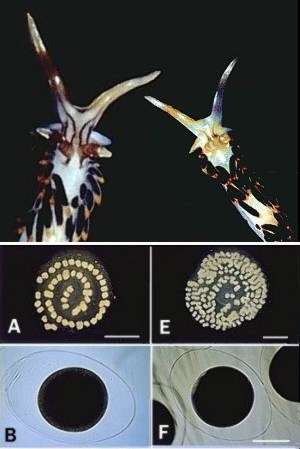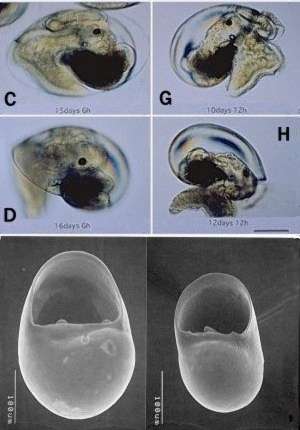

Eggs - differences between species
PHOTO
Comparative series of photos:
LEFT: Facelina quadrilineata
RIGHT: Facelina bilineata.
Row 1: Showing 4 and 2 lines on head.
Row 2: Egg mass. Scale = 1mm.
Row 3: Egg and capsule. Scale = 100 microns.
Row 4: C, veliger about to hatch (15.3 days).
G, veliger just hatched (10.5 days).
Row 5: D, 1 day after hatching.
H, 2 days after hatching.
Row 6: Shells of newly hatched veligers.
Scale bar = 100 microns.
PHOTOS: Yoshi Hirano.
Often, the shape and nature of egg masses and larval development can give us important clues to the identity of a species. In some cases, very similarly coloured species can only be separated by subtle differences in the spawn and embryonic development.
This series of photos by Yoshi Hirano are a good example of the importance of these structures in species identity. The differences shown in the photos caused him to investigate the anatomy of apparent colour morphs of F. quadrilineata (Baba, 1930) further and show that there were two species, Facelina quadrilineata, and a new species, Facelina bilineata.
These two sympatric species have a slightly different colour pattern, their egg masses are slightly different in colour, and as can be seen in the photos, one has fewer and larger eggs in the egg mass. The time required for embryonic development in Facelina quadrilineata is consistently longer (about 15 days) than for Facelina bilineata (about 11.5 days), and the size and shape of the veliger shells is quite different. Both species have lecithotrophic (non-feeding) larvae which spend only a short time in the plankton before settling on to the substrate and metamorphosing into small slugs. See Yoshi Hirano's wonderful photos of veligers of Flabellina amabilis settling from the plankton and metamorphosing.
References:
• Ito, M. & Hirano, Y.J. (1996). The spawn and development of two colour morphs of the aeolid nudibranch Facelinella quadrilineata (Baba, 1930). Venus (Japanese Journal of Malacology), 55(2): 115-121.
• Hirano, Y.J. & Ito, M. (1998). 'Facelinella quadrilineata' (Baba, 1930), a pair of cryptic species of Facelina from Japan. Zoological Science, 15: 791-797.
Rudman, W.B., 1999 (June 26) Eggs - differences between species. [In] Sea Slug Forum. Australian Museum, Sydney. Available from http://www.seaslugforum.net/find/facedev
Related messages
Opisthobranch ova & capsules
October 21, 2000
From: Cynthia Trowbridge
Dear Bill,
Hi. Yet another query that has long puzzled me. I have tabulated the number of ova per capsule in NE Pacific sacoglossans (ascoglossans) . Most species have just one per capsule. But, there are at least 4 species that have more than one:
Lobiger souverbiei - up to 5
Elysia hedgpethi - 1-2
Elysia diomedea - 6-14
Stiliger fuscovittatus - 1-2
I was wondering if there was any biological significance for the inter-specific variation or the intra-specific variation? The latter is particularly troubling to me, particularly after reading an account for S. fuscovittatus that cases with 2 ova per capsule do not develop. Some of the variation is within individual egg masses. Has anyone ever noted that sacoglossans with multiple embryos per capsule do actually develop? Has anyone noted the intra-specific phenomena in other opisthobranchs?
Any thoughts or suggestions would be much appreciated!!
Cheers,
Cynthia
trowbric@ucs.orst.edu
Trowbridge, C., 2000 (Oct 21) Opisthobranch ova & capsules. [Message in] Sea Slug Forum. Australian Museum, Sydney. Available from http://www.seaslugforum.net/find/3132Re: Opisthobranch ova & capsules
October 21, 2000
From: Chad Sisson
Cynthia,
Concerning your message. This past summer I found an extraordinarily large Dendronotus frondosus in Eastport, Maine. I collected an egg mass an was surprised to find that some of the capsules had 2 embryos. I have never seen this before in this species, and attribute it to the enormous size of the parent. The double embryo capsules developed normally and hatched with their siblings, but I do not know if they were metamorphically competent because they are planktotrophic larvae. The hatched veligers did have a shell much larger than any other D. frondosus larvae I have collected.
Unfortunately, I do not have photos or any other data to share, but if I see it again I will let you know.
Chad Sisson
cgsisson@cisunix.unh.edu
Sisson, C., 2000 (Oct 21) Re: Opisthobranch ova & capsules. [Message in] Sea Slug Forum. Australian Museum, Sydney. Available from http://www.seaslugforum.net/find/3218Dear Chad,
Thanks for the information. I think your reply arrived within 15 minutes of me posting Cynthia's message. That must be a bit of a record!
Best wishes,
Bill Rudman.
Facelina quadrilineata, F. bilineata from Japan
June 26, 1999
From: Yoshi Hirano
Hirano, Y., 1999 (Jun 26) Facelina quadrilineata, F. bilineata from Japan.
[Message in] Sea Slug Forum. Australian Museum, Sydney.
Available from http://www.seaslugforum.net/find/976
Yoshi Hirano has kindly sent a series of photos showing the subtle differences in egg mass, size, and embryonic development between Facelina quadrilineata and Facelina bilineata. I have arranged them on a separate page illustrating how important these characters can be in distinguishing species.
Dr Yoshi Hirano is at the
Kominato Marine Laboratory,
Chiba University,
Amatsu-Kominato, 299-5502
JAPAN
hiranoyj@earth2.s.chiba-u.ac.j
Bill Rudman.
